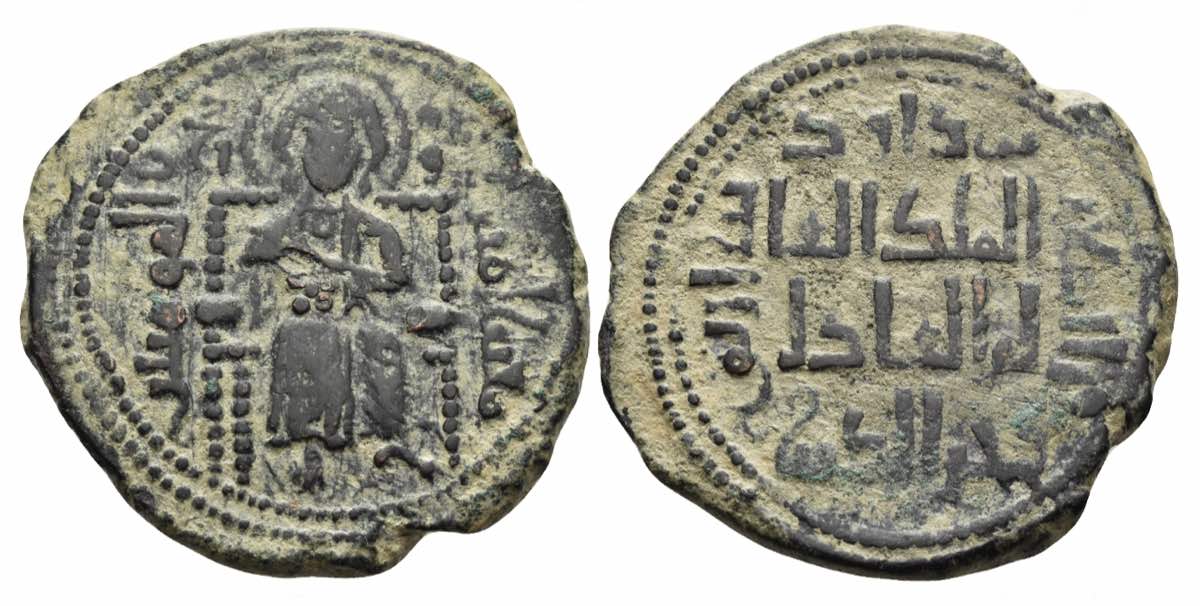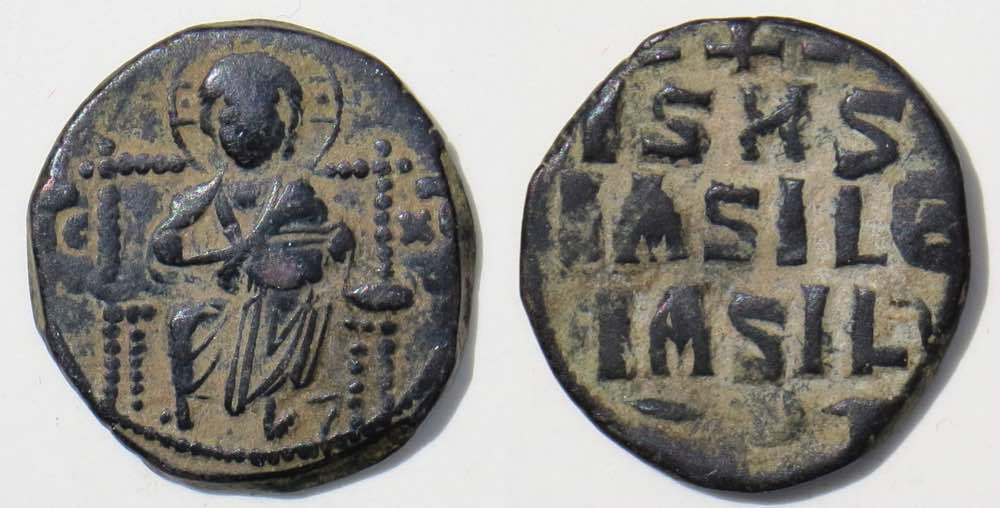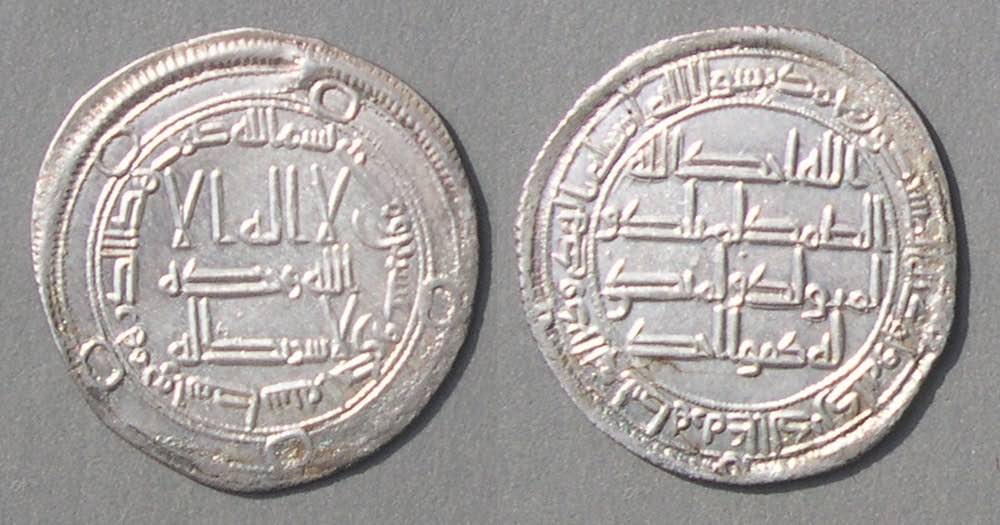Turkoman figural types. Coins of the "Foes of the Crusaders."
Most Islamic coin types consist of Arabic legends without images, but in the 12th and 13th centuries Turkoman rulers in eastern Turkey and Syria issued figural types with images of humans or animals. Some imitated earlier Byzantine types with Christian images!
Here is one of the earliest Turkoman figural types, struck by the first Artuqid ruler to issue figural types. Compare it with the second coin, below, and note how the obverse on this Islamic coin imitates a Byzantine coin with an image of Christ!
 Artuqid Dynasty. Fakra al-din Qara Arslan
Artuqid Dynasty. Fakra al-din Qara Arslan
AH 539-570. AD 1144-1174.
Struck c. 539/540/1145-1146.
28-25 mm. 9.95 grams.
Christ seated on high-backed throne facing (just like on Byzantine Class D anonymous folles)
Arabic up right and down left of throne:
"Helper and Commander of the Faithful"
Uncertain letters, possibly numerals, left and right of the head.
Reverse has legend in three lines in Arabic (Kufic) continuing on right, top, and left. It gives the ruler's titles, names, and pedigree back three generations.
bin Artuq up left (his great grandfather),
Qara Arslan down right.
bin Daud (across top--his father.)
al Malik al a/lim al-adil/Fakhr al-Din
Spengler and Sayles 2.1. Wilkes 1173.
The next Byzantine type is the model, from a hundred years earlier, for the above Artuqid obverse.
 Byzantine anonymous follis of "Class D. "
Byzantine anonymous follis of "Class D. "
Sear 1836. Constantine IX, 1042-1055.
In DOC, dated by Grierson to "c. 1050 - c. 1060,"
(Constantine IX, 1042-1055 and Constantine X, 1055-1067.)
Class D, Sear 1836
25 mm. 8.68 grams.
Christ seated on high-backed throne facing
Small IC left and XC right
Lovely earthen highlighting.
ISXS (Jesus Christus)
bASILE (king of)
bASIL (kings)
Byzantine Class D coins are very common.
There are only about 100 Turkoman figural bronze types, few enough to make a collectible series, but including numerous rare types to challenge the collector. Acquiring a coin wouldn't be much fun and it wouldn't be very special if it weren't a challenge!
Some history. The First Crusade to retake the Holy Land was called in 1096. It conquered the eastern Mediterranean coast including the cities of Antioch, Edessa, Tripoli, and Jerusalem, each of which which then hosted their own crusader states. The crusaders came in contact with the Artuqids, Seljuks, and Zengids, who are sometimes called "foes of the Crusaders." In the mid 1100s, unlike other Islamic states, they began to issue coins with "figural" types. Often one side is figural and the other a long legend in Arabic. Many Turkoman figural types are inspired by Byzantine types from as much as five centuries earlier and some resemble Greek types. Very remarkable is that some of the types reproduce Christian types on Islamic coins!
Earlier history. In 622 Mohammad initiated the Islamic era by migrating from Mecca to nearby Medina. In the 630s and 640s his successors overran the Persian Empire and Byzantine territory which included the coast of the eastern Mediterranean and much of north Africa. By 737 Arabs had conquered the middle East, North Africa, most of Spain, and the eastern part of what is now Turkey. At that time the Turks were in the region north of and between the Caspian and Aral Seas and still minor players. By 900 the vast Islamic world had split into numerous competing states. In 1071 the Seljuks, a Turkish tribe, defeated the Byzantines in the decisive battle of Manzikert (now in eastern Turkey) and occupied most of Asian Turkey. All during these first 500 years Arabic silver and gold coin designs emphasized legends, not figures.
Legends. Just to illustrate what most early Arabic coins look like, here is an common early silver dirham with only legends:
 26 mm.
26 mm.
Silver dirham
Arabic legends, both sides
"In the name of Allah/was minted/this dirham/at Wasit/ year 1 and 20 and 1 hundred," around the reverse.
This coin is from AH 121 which is AD 738/9.
Hisham was the Caliph of Damascus at the time, so this is attributed to "Hisham" although it does not say his name on the coin.
The mist of Wasit was on the Euphrates west of Basra.
Almost all early "Arabic" or "Islamic" coins have legends as types on both sides. That is what makes figural bronze so unusual.
 Artuqid Dynasty. Fakra al-din Qara Arslan
Artuqid Dynasty. Fakra al-din Qara Arslan Byzantine anonymous follis of "Class D. "
Byzantine anonymous follis of "Class D. " 26 mm.
26 mm.